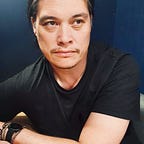I’ve resisted the urge to write this blog for a long time.
There are a sea of fantastic resources about how to discover and deliver on the unmet needs of customers, and out of my own feelings of insecurity I didn’t want to put a ‘cute’ heuristic into the world when I’m not sure if it adds value to the conversation.
But yet, here we are and it all started with ….
A man walking a goldfish on a suburban street.
When I first saw this photo I thought …
- How does this benefit the goldfish?
- Do goldfish need environmental change to feel happier?
- Does this enhance the owners bond with the goldfish?
( 😳 I really do think too much.)
Around the same time I saw this photo, I was being introduced to the Japanese philosophy of life called Ikigai.
What is Ikigai?
The word is derived from ‘ikiru’ meaning to live and ‘kai’ meaning the ‘sensation of what hopes for’. Together these create a definition for a persons ‘reason to live’ or having a ‘life purpose’.
I won’t go deep into this practice, but its said to find your Ikigai you ask yourself 4 questions:
Thinking about the purpose of the fishwalker along with the question … What the world needs? … led me to ponder …
🧐 If a person has an Ikigai, could a product (or service) have an Ikigai as well based upon what human needs it fulfils and the value it creates?
What is a Product’s Purpose for Being?
To try and answer this question, I chose 4 high level needs that a product can fulfil to create value for a person.
This was loosely based on Maslow’s famous (or infamous) hierarchy of needs and this article by Larry Kim.
The four high level needs I chose were:
Functional Needs
These could be considered practical needs, things people need to get their tasks completed. For example: Saving Time, Reducing Risk, Gathering information to make a decision.
Physical Needs
Are the requirements for us to sustain ourselves.
Food, shelter, water, human connection etc ..
Emotional Needs
What we need to experience … (insert emotion)…
Financial Needs
This is the income or expenditure required for people to live and work. It would include the need to generate income and pay debts through to higher order financial needs such as being able to create savings and make investments.
And just like the Ikigai graphic, these were placed into a Venn diagram.
This then raised another question …
🧐 What’s created at the intersection of these four high level needs?
I’m still trying to figure this out, but it’s what I consider to be the ‘nature’ of a product or service.
Functional + Physical = Utility
Water, Electricity, Walking aids
Physical + Emotional = Wellness
Air BnB, Anti depressants, gym memberships
Emotional + Financial = Symbolic
Paying for Instagram Followers, Yeezys, Star Wars Toy Collection
Financial + Functional = Security
Insurance, Superannuation
How do I use Product Ikigai?
1. Explore a customer’s jobs to be done.
(Especially helpful when completing customer value propositions )
Jim Kalbach defines Jobs to be Done (JTBD) as the ‘art of focusing on people’s objectives independent of the means used to accomplish them’.
When seeking to understand a person’s JTBD, Product Ikigai helps get me started by prompting me to consider a persons objectives against the 4 needs.
For example, let’s look at having a clean house.
Functional Objectives
I’d prefer an alternate way to clean the house since it takes up time that I’d like to devote to other activities.
Physical Objectives
Being someone who experiences allergies, a clean house will reduce the amount of dust in the air.
Emotional Objectives
A clean house makes me feel less overwhelmed and frazzled.
Financial Objectives
A clean house increases the value of my property or shows my landlord that I am taking care of the property — hence reducing the possibility of a rise in rent.
2. As a lateral thinking aid for creating different ways to look at the nature of a product or service?
Once again if we look at a standard house cleaning service
(Which I’d consider to be a Utility service)
👉🏼 What would it look like if it was imagined as a Wellness product or service? 👉🏼 How about a Symbolic product?
These provocations start to open up my perspective on the nature of products and services.
3. To help identify unique partnership opportunities.
If we consider house cleaning to be a Utility product, what could be created by partnering with a Financial product? For example a partnership between a cleaning service and a bank. What customer value could be unlocked in offering a moving house cleaning service for customers of the bank who have recently sold their home?
I’m still exploring ways to use Product Ikigai as a tool to help unlock my creativity and increase my levels of cognitive empathy.
What’s Next for Product Ikigai?
❓❓The next mystery I’m working on is defining what exists at the next level down of intersection between the circles …
Thanks for reading 💛 If you’d like to chat about Product Ikigai or any of my other blogs you can contact me here.
